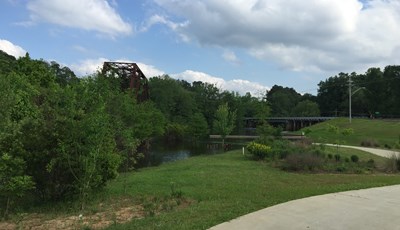Riparian and natural resource professionals discussed current innovations and issues in riparian restoration and management at the Urban Riparian Symposium: Balancing the Challenges of Healthy Urban Streams Feb. 15-17 in Houston at Rice University’s BioScience Research Collaborative Building.
More than 48 presentations, 10 posters and three workshops were included in the symposium, as well as a field trip to a restoration site on a tributary of Big Gulch.
Natural resource and water agencies’ staff, river authorities’ staff, policy makers, city and county staff, managers, landscape architects and engineers were among the 131 professionals attending, said Nikki Dictson, Texas Water Resources Institute (TWRI) Extension program specialist who organized the symposium. She said having professionals of various backgrounds helped make the event a success.
“Successful riparian projects require expertise from many different disciplines, so our goal was to help bring them all together to collaborate and connect at one meeting,” Dictson said.
The symposium was hosted by TWRI, Texas Riparian Association, Texas Parks and Wildlife Department, Texas A&M Forest Service, Upper Trinity Regional Water District, USDA Natural Resource Conservation Service and the Severe Storm Prediction, Education, and Evacuation from Disasters Center.
Keynote speakers were Linda R. Cox, executive director of the Bronx River Alliance and Bronx River administrator for New York City Parks; Dr. Ann L. Riley, watershed and stream protection/restoration adviser for the San Francisco Regional Water Quality Control Board; and Carolyn White, conservation manager at Memorial Park Conservancy in Houston.
Other presenters discussed management of riparian areas, restoring urban bayous and streams, stormwater and low impact development, protecting riparian areas, outreach and education, restoration projects and best management projects and watershed development effects, Dictson said.
“We wanted to connect and discuss urban riparian and river issues that everyone is facing, to discuss how restoration projects could become more effective, efficient and successful in Texas with professionals from all aspects of these issues,” she said.
Dictson said the 25-minute moderated sessions, which occurred after concurrent sessions, led to productive conversations about collaboration and community engagement, data gaps, flooding issues and restoration strategies. This also led to more networking opportunities and interaction between researchers, policy makers, and practitioners, she said.
In addition to presentations, the symposium also facilitated a poster session, receptions and workshops. The workshops covered grant writing for urban riparian projects, managing riparian restoration in urban areas and managing vegetation in stream restoration projects.
Sponsors included U.S. Department of Agriculture’s National Resources Conservation Service, Texas Parks and Wildlife Department, Texas A&M Forest Service, Texas Riparian Association, R.G. Miller Engineers, Severe Storm Prediction, Education, and Evacuation from Disasters Center, Upper Trinity Regional Water district, Upper Trinity Conservation District, Asakura Robinson, Freese and Nichols and Save Buffalo Bayou.
To learn more, visit the Texas Riparian Association website or Facebook page.



